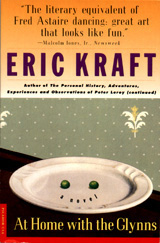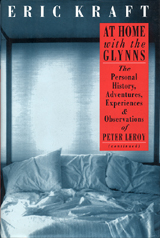
YOU CAN READ
THE FIRST HALF OF
THE BOOK
(21 CHAPTERS)
HERE,
ONLINE,
OR,
FOR MAXIMUM PORTABILITY
AND CONVENIENCE
WHEN READING
ON THE BEACH
OR
IN THE TUB,
YOU CAN BUY THE
PICADOR USA
PAPERBACK EDITION AT
AMAZON.COM
OR
BARNES&NOBLE.COM
OR
YOU CAN DOWNLOAD
THE COMPLETE TEXT
AS AN
eBOOK
AND
READ IT ON A PDA.

|
Chapter 17
I Become Aware of a Certain Yearning
 FOUND that all the talk about drawing was making me twitchy, eager, and
impatient. Earlier that morning, I had found myself awakened by a
desire, the way I might have been awakened by the sun. Perhaps desire
is too strong a word. I suppose it was just an urge. I wanted
to learn to paint—really wanted to learn to paint, not just as a
way of getting Andy to consent to my walking the girls to the movies, but
for some reason of my own that was not yet clear. What had aroused
that urge? Maybe it was the smell of paint and turpentine that lingered
in my memory from my single visit to Andy’s studio. Maybe it was
the tactile memory of the roller in my hands, the willed effort I had invested
in controlling it as I’d moved it across Andy’s canvas in the act of representation.
More likely, I think, was the possibility that I’d been sold on the idea
by the matchbook advertisements distributed by the Past Masters Correspondence
School, an outfit that offered instruction in everything from plumbing
to poetry, all in the privacy of your own home, through lessons devised
by professionals recently retired from the discipline of your choice.
FOUND that all the talk about drawing was making me twitchy, eager, and
impatient. Earlier that morning, I had found myself awakened by a
desire, the way I might have been awakened by the sun. Perhaps desire
is too strong a word. I suppose it was just an urge. I wanted
to learn to paint—really wanted to learn to paint, not just as a
way of getting Andy to consent to my walking the girls to the movies, but
for some reason of my own that was not yet clear. What had aroused
that urge? Maybe it was the smell of paint and turpentine that lingered
in my memory from my single visit to Andy’s studio. Maybe it was
the tactile memory of the roller in my hands, the willed effort I had invested
in controlling it as I’d moved it across Andy’s canvas in the act of representation.
More likely, I think, was the possibility that I’d been sold on the idea
by the matchbook advertisements distributed by the Past Masters Correspondence
School, an outfit that offered instruction in everything from plumbing
to poetry, all in the privacy of your own home, through lessons devised
by professionals recently retired from the discipline of your choice.
These lessons were very popular at the time.
Smoking was also popular at the time, and the Past Masters used matchbooks
to recruit their students. Their approach to advertising was very
simple, almost childish. It was derived from a basic schoolyard challenge
that began “Betcha can’t,” and went on to trouble. Among the “Betcha
can’t” challenges that I can recall accepting, to my regret, were “Betcha
can’t hit that window with this rock” and “Betcha can’t climb up that ivy
all the way to the roof of the school.” You get the idea. The
Past Masters simply omitted “Betcha can’t” and printed the heart of the
challenge on each of the matchbook covers that touted one of their correspondence
courses. The one for the taxidermy course showed a cartoon raccoon
over the challenge “Stuff Me!” The one for plumbing showed a dripping
faucet over “Stop Me!” The one that got me, the one for the art course,
showed the profile of an attractive young woman over the challenge “Draw
Me!”
Inside the matchbook, there were instructions about
the dimensions of the drawing one should make, a warning against tracing,
the reassurance that one could work in any medium, and the information
that “the admissions board of the Past Masters Correspondence School will
review your drawing and decide whether to extend to you an invitation to
enroll in the fine arts course.” I decided that the real challenge
was hidden within this deceptively simple statement. Anyone who had
been attracted by the cover, opened the matchbook, and read the rules and
regulations inside was meant to detect the challenge and take it.
I did, or at least I tried to. When I read those words, I said to
myself, just as the Past Masters intended me to, “I know what they mean
by that. They think I’m not good enough for them. They think
I can’t draw that girl. I can. I could. Anytime.
If I wanted to. If I felt like it. If I wanted to take the
trouble.” Sometimes I took the trouble and actually did try drawing
the perky woman, and sometimes I thought of sending my drawings in to the
Past Masters to see if they’d be willing to let me enroll in their school,
but I was always troubled by the question of how good a drawing they were
looking for. I would look at my drawing of the girl on the matchbook
cover and try to decide whether it was good enough—or bad enough—to
qualify me for admission.
On the one hand, I supposed that the drawing should
show some talent, at least a talent for mimicry. If it didn’t, I
could imagine receiving a letter from the Past Masters beginning with something
along the lines of “We’re terribly sorry, Mr. Leroy, but you simply haven’t
got the knack.” On the other hand, the drawing shouldn’t be too
accomplished. If it was, what would be the sense of my pursuing the
course? The Past Masters would send me a letter beginning with something
like “We’d love to have you in the school, Mr. Leroy, but we’re afraid
that there simply isn’t anything we can teach you.” In either event,
whether I erred on one side or the other, I was going to be turned down.
I put quite a bit of time into wondering about where the successful drawing
ought to fall along the continuum from inept to adept, and even more time
working and reworking my drawings to try to strike the right balance, but
I never quite felt that I’d found it, and since I didn’t want to have to
suffer the disappointment of being turned down, I never applied.
Now, however, I had made the bold step. I
had already made my qualifying drawing for Andy Glynn, and he had as much
as invited me to enroll in the Andy Glynn School of Art. Perhaps
it was the notion that I’d already been accepted that made me want to attend.
For whatever reason, I wanted Andy to teach me to paint. Earlier
that morning, when the urge had awakened me and I had recognized it for
what it was, I had lain there in bed annoyed by the time that stood between
me and my first lesson. (Excuse me while I chuckle, for I’ve often
felt the same since. That impatience is one of the traits of my childhood
self that survives in the adult: an idea comes to me in the night, an idea
intriguing enough to wake me when I know that I need a real night’s sleep,
undisturbed, and I lie there, thinking, wishing that the night would end
or wishing that the thought would leave me, go away for a while now and
let me get my rest, come back some other time, in the morning, or on another
day, when I’m in a position to use it. It never does. Ideas
can’t be willed away.)
Anyway, I wanted to learn to paint, and since I
had only one model for what it meant to paint, I wanted to learn to paint
exactly as Andy did. After all, I had some experience with rollers.
Why not put it to use?
Andy walked into the kitchen and took a roll from
the platter. “Mr. Glynn,” I said. “Hello.”
“Peter,” he said. “Hello.” He tore the
roll in half without any apparent regard for its significance as an emblem
of hope.
“Here I am,” I said.
He looked at me, stepped back a bit, tilted his
head downward and regarded me, threw his head back and regarded me, tilted
his head to one side and regarded me, and said, “No doubt about it.”
“I’m ready,” I said.
“For what?” he asked.
“For you to take me on—you know, as a student.”
“You make it sound like wrestling.”
“Heh-heh—”
“Of course, with many of my students, it is
something like wrestling.”
“I just meant ‘take me on,’ add me to the list,
make me one of your students.”
“I don’t think that’s within my power, but—just
out of curiosity—which one did you want to become?”
Rosetta frowned comically and said, “Andrew,” without
adding, “stop teasing him—he’s only a kid.”
“Well,” I said, “I guess I meant that I would like
to have you teach me to paint.”
“Teach you to paint?”
“Yes, sir. You said maybe you could.”
My voice dropped. I had no arguments in my favor, nothing beyond
the clam I’d painted. “Yesterday,” I reminded him.
“Sure,” said Andy, as if it were nothing.
“I’ll teach you.” He reached toward me to put a fatherly hand on
my shoulder. I cringed. I tried not to, but I’m afraid that
I did, only slightly, but still I cringed.
“Don’t let me frighten you, Peter,” he said.
“No, sir,” I said.
“Call me Andy.”
“Okay.”
“So you want to learn to paint?”
“Yes, sir—Andy,” I said. “I want to learn
to paint like you.”
“Really? How do I paint?”
“Well—I don’t actually know, you know, but my neighbor,
Mrs. Jerrold, says you make big swoops and whooshes with the paint.”
“That’s pretty accurate,” he said.
“So that’s what I want to learn—you know, abstraction.”
“Abstraction,” he said. “We’ll have to have
a talk about that. Come on.”
He made a gesture for me to follow, and he headed
toward his studio. I found that I was full of nervous expectation.
When I began to walk, my legs seemed not to recall how it was done.
It seemed like a new skill, something Andy was going to have to teach me.
I had the motivation of a runner in a dream, but the frustration of dream
running, too, when I couldn’t make myself move through the dream stuff,
the atmosphere of dreams that manacled me with rubbery air. There
in the Glynns’ kitchen, in real life, the effect wasn’t as severe as it
was in dreams, but even so I strained to make myself move and barely managed
to shuffle a foot in the direction of the studio.
What’s the matter with me? I wondered, and
went on wondering, more or less along the following lines. Whence
comes this mixture of anxiety and eagerness? From the expectation
that my lessons are about to begin, that Andy is going to tell me something,
show me something, or require something of me that will, if not immediately,
then in years to come, when I look back at this moment, prove to have been
the thing, the single thing, that first lifted for me the veil that hid
the secrets of his art, of art itself? The secrets were what
I needed. As far as I was concerned, my career as a painter had already
begun. After all, hadn’t I drawn a clam under the eye of the master
himself?
“Peter!” he called. “Where are you?”
While I had been imagining my older self returning
to this moment with recollected affection, Andy had made his way to the
studio.
“Sorry, sorry—here I come,” I called, hastening
to the master’s side.
“What happened?” he asked. “Cold feet?”
“I was just—um—”
“Daydreaming,” he said.
“Yes, sir,” I said.
Andy let some time pass without saying anything.
He rummaged around in some boxes where he had an assortment of what looked
like junk to me. After a long while, he found, apparently, what he
wanted: a box of modeling clay, for children, in several colors.
He began kneading some of it in his hands, warming it up, and he said,
almost as if it had just occurred to him, “Abstraction.”
“Yes, sir,” I said. “I mean Andy.”
“Well, now, you see,” said Andy. His voice
had changed. He sounded a great deal like my grandfathers when they
were teaching me how to do something difficult—crab, say, or clean the
points in a distributor. They would speak to me with exaggerated
kindness and consideration, to acknowledge and encourage my enthusiasm,
while making it clear to me that everything I was doing was wrong.
“See what?” I asked, wondering what it was that
I was doing wrong.
“It’s not that simple.”
“Oh.” That made it a lot like crabbing and
cleaning the points in a distributor.
“You see, you must come to abstraction from somewhere
else.”
“Oh?”
“I think so. For example, you might start
by trying to replicate exactly what you see. That’s one way
you might start. Not the only way, you understand.”
“Okay.”
“So you start by trying to make on the canvas exactly
what you see, and I mean what you see, not what everyone
sees, or what you suppose everyone should see, or what someone
would
see if all the impediments to seeing were removed. Do you see?”
“Sure,” I said automatically, because it is what
a student learns to say, but in a moment I thought that, maybe, I did see,
even though I was confused. Earlier, I hadn’t even considered that
learning to paint would involve so much emphasis on seeing, but I could
see now that seeing was the threshold of the house of art. “I mean
that I see a little,” I said with some pride.
“Ah! Very good! You’re an honest boy!
You will need that! You will definitely need that!”
“Uh-huh. Okay.” For some reason, I felt
uneasy when he praised me for my honesty.
“Aha!” he said. “I think you’re a little uneasy
when I praise your honesty.”
I shrugged.
“Perhaps you’re not always so honest. Hm?
Maybe sometimes you bend the truth a bit. Shape it to your needs.”
He picked up a lump of clay about the size of a
pea and rolled it between his fingers.
“There are lots of reasons for doing that,” he said.
“Bending the truth, I mean. For one thing, you might just want to
make it look better.” He held the bit of clay up for me to see.
He had smoothed it in his rolling, and flattened it slightly before he
held it out, so that it looked like a smooth-skinned grape. I was
dumbfounded.
“Not much,” he said, regarding his handiwork.
Then, with his other hand, he gave the lump half
a twist. Now it inspired curiosity, it was partly hidden and partly
revealed, and it had a sinuosity that was attractive in itself.
“Much more interesting,” he said. “Still a
lump of clay, but more interesting. I could say that the truth
is that it’s just a lump of clay. So, maybe you sometimes bend the
truth to make it a little more interesting. Do you understand?”
“I think so,” I said.
“Any questions?” he asked.
“Well, yes,” I said.
“Fire away,” he said. “You won’t learn anything
if you don’t ask questions.”
“Okay,” I said. “What happened after you and
Mrs. Glynn got across the border?”
|

|



 Here
are a couple of swell ideas from Eric Kraft's vivacious publicist, Candi
Lee Manning:
Here
are a couple of swell ideas from Eric Kraft's vivacious publicist, Candi
Lee Manning: